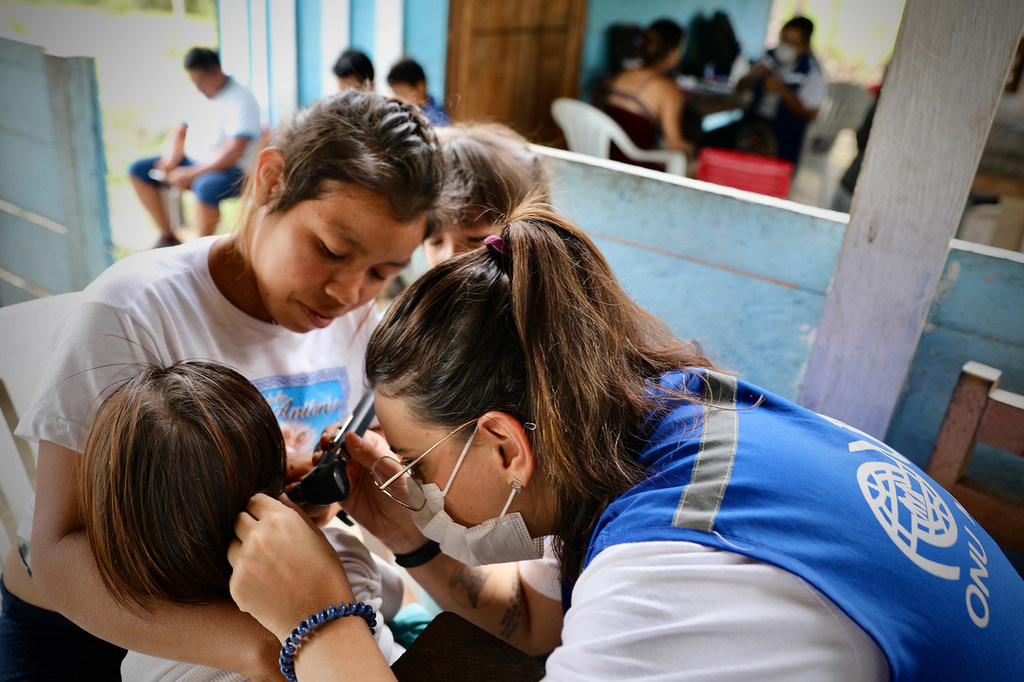In Roraima, in northern Brazil, a medical vehicle descends a steep road, raising a cloud of dust. It is one of the Mobile Health Units of the International Organization for Migration (IOM) that helps bring medical assistance to the indigenous people of Venezuela and their host communities in one of the most difficult-to-reach areas in Brazil.
The State of Roraima is the main entry point from Venezuela to Brazil for those fleeing the current social and economic crisis in that country. Many of the more than 400,000 Venezuelans currently living in Brazil entered the country through this northern state.
“In general, people find a doctor close to where they live, but for thousands of them who live in rural communities, health care is hours away,” a UN agency doctor named Maria Chan said at the end. after a long day of consulting.
In order to cooperate with the solution to this problem, the IOM has decided to hire medical personnel, who travel to the door of those who might need them.
“Indigenous people are among the most vulnerable populations. These services truly change the lives of people with chronic illnesses in rural communities; they make their lives easier,” adds Chan.
A group of indigenous people wait their turn for a medical evaluation in northern Brazil.
Migrants, refugees and host communities
The mobile units are fully equipped to provide Venezuelan migrants, including refugees and host communities, with much-needed health care, including essential treatments and medicines once a month.
Two Mobile Health Units reach the most vulnerable populations in the region and train community health agents so that they can provide primary health care to rural patients.
Indigenous communities in the region may suffer from various chronic diseases, such as hypertension and diabetes, child malnutrition, fungal infections on the skin, parasites and sexually transmitted diseases (STD). Most of these people do not have access to health centers.

An elderly indigenous woman waits her turn for a medical consultation in a remote village in northern Brazil.
Life saving care
In a small room in an open school in Sakao Motá, a remote indigenous village where locals and Venezuelans live side by side, people wait in sweltering heat for the doctor to call them for medical checkups.
Katiuska Fernández, 31, sits quietly next to her eight-year-old son. She is six months pregnant.
“The nearest hospital is an hour’s drive from here and we don’t have the money to pay for a taxi or any other means of transportation,” she says as she waits for her regular maternity check-up. “I’m very happy that everything is okay.” . This health care has changed our lives”.

IOM doctor Maria Chang conducting consultations in a remote indigenous village.
8000 beneficiaries
In 2018, food and medicine shortages, along with growing insecurity, put pressure on Katiuska and her family of five to leave their small community in Venezuela near the border. They sold all their belongings and crossed the border with other Taurepang families. Since then, the subsistence agriculture they developed in the host community has helped them survive.
Last year, IOM health teams attended medical and psychological consultations of approximately 8,000 migrants in vulnerable situations including refugees and members of host communities throughout Roraima, with an average of 30 people daily.
Medical care included general health checks, tests for sexually transmitted diseases, COVID-19, blood glucose, pediatric medicine, and prenatal consultations.

IOM staff delivering medicines to patients from the Mobile Health Unit.
Severely impacted by migration
Located on the indigenous lands of São Marcos – a set of settlements under a scorching sun where the Tauperang people live – Sakao Motáis is one of the indigenous communities most severely impacted by the flow of Venezuelan migrants, including refugees. Other communities on the border between Brazil and Venezuela that have also been affected are Ta’rau Parú, Par Bananal, and Sorocaima.
There are 160 Venezuelan indigenous peoples belonging to the Taurepang group who currently live in Sakao Motá. Before the arrival of the Venezuelans the town had only 100 residents.
Despite the fact that the agricultural resources of the village are under great pressure, Venezuelans have been well received as they are part of the same indigenous group who share linguistic origins and kinship ties.
Sitting under a tamarind tree, Silvano Fernández, a 55-year-old indigenous Brazilian man, recalls how his community opened its arms to his brothers and sisters from Venezuela.
“They are our relatives; we must welcome them because they are our people. Today it’s them, but tomorrow it could be us“, it states.
Silvano is one of the regular patients of the medical unit. He suffers from chronic pain caused by a car accident, which prevents him from having a normal life.
Even though Katiuska’s health status in relation to her pregnancy has been improving by attending regular check-ups, since she does not have a vehicle or a telephone signal, she has had no choice but to prepare to give birth at home. when that time comes.
“If I can’t get transportation to the nearest hospital, my baby will have to be born at home in the community, as all my ancestors have been,” she says after receiving prenatal care.
This story was written by Gema Cortés, IOM Press Unit, Office of the Special Envoy for the Regional Response to the Situation in Venezuela.















